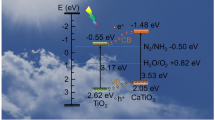Abstract
Photocatalytic nitrate removal to produce recyclable netrogen (N2) without using chemical reductants is regarded as an environmentally friendly and effective technology for denitrification. However, the sluggish cathode reaction kinetics severely hampered the efficiency of nitrate reduction reaction (NO3RR). Developing high performance photocatalyst is highly pursued for boosting NO3RR. In this study, Bi2MoO6 nanosheets with massive oxygen vacancies are fabricated through hydrothermal reaction and subsequent plasma modification. Maximal nitrate conversion yield of 38% with the high N2 selectivity of 80.0% is achieved for photocatalytic NO3RR. The underlying photocatalytic mechanism is systemically investigated through comprehensive approaches. The enhanced nitrate conversion efficiency is mainly attributed to the synergistic effect between deliberately generated oxygen vacancies and Mo active sites, capturing O and N atoms of nitrate, respectively, thus promoting the adsorption of nitrate and cleavage of N–O bond. Furthermore, the H “repulsion” effect of Bi efficiently suppresses hydrogenation reaction, resulting in greatly enhanced N2 selectivity.
Graphical Abstract

The generation of oxygen vacancy leads to the cleavage of N-O bond in NO3-, which also enhances the adsorption of nitrate. The specific adsorption of nitrogen on active Mo site is enhanced, and the repulsion of element Bi to protons enhances the selectivity of N2 in the product.




Similar content being viewed by others
References
Anjana SU, Iqbal M (2007) Agron. Sustainable Dev 27:45–57
Garcia-Segura S, Lanzarini-Lopes M, Hristovski K et al (2018) Appl Catal, B 236:546–568
Saravanakumar D, Song J, Lee S et al (2017) Chemsuschem 10:3999–4003
Ensie B, Samad S (2014) Desalination 347:1–9
Su JF, Ruzybayev I, Shah I et al (2016) Appl Catal, B 180:199–209
Tałałaj IA, Biedka P, Bartkowska I (2019) Environ Chem Lett 17:1177–1193
Liu C, Dermody D, Harris K et al (2017) ACS Comb Sci 19:422–436
Sposob M, Bakke R, Dinamarca C (2017) Bioresour Technol 233:209–215
Ma J, Yang Q, Wang S et al (2010) J Hazard Mater 175:518–523
Fessenden RW, Meisel D, Camaioni DM (2000) J Am Chem Soc 122:3773–3774
Bems B, Jentoft FC, Schlögl R (1999) Appl Catal, B 20:155–163
Cook AR, Dimitrijevic N, Dreyfus BW et al (2001) J Phys Chem A 105:3658–3666
Chen F, Yang Q, Wang Y et al (2017) Appl Catal, B 205:133–147
Li H, Shang J, Ai Z et al (2015) J Am Chem Soc 137:6393–6399
Di J, Zhao X, Lian C et al (2019) Nano Energy 61:54–59
Guo Q, Zhou C, Ma Z et al (2016) Chem Soc Rev 45:3701–3730
Li H, Li J, Ai Z et al (2018) Angew Chem Int Ed 57:122–138
Serpone N (2006) J Phys Chem B 110:24287–24293
Li H, Sun B, Xu Y et al (2018) J Colloid Interface Sci 531:664–671
Dou S, Tao L, Wang R et al (2018) Adv Mater 30:1705850
Zhao J, Chen Z (2017) J Am Chem Soc 139:12480–12487
Geng J, Ji S, Xu H et al (2021) Inorg Chem Front 8:5209–5213
Greeley J, Jaramillo TF, Bonde J et al (2006) Nat Mater 5:909–913
Wu S, Xiong J, Sun J et al (2017) ACS Appl Mater Interfaces 9:16620–16626
Zhang N, Jalil A, Wu D et al (2018) J Am Chem Soc 140:9434–9443
Dai W, Long J, Yang L et al (2021) J Energy Chem 61:281–289
Li Y, Go YK, Ooka H et al (2020) Angew Chem Int Ed 59:9744–9750
Chen Y, Yang W, Gao S et al (2018) ACS Appl Nano Mater 1:3565–3578
Kongmark C, Coulter R, Cristol S et al (2012) Cryst Growth Des 12:5994–6003
Li G, Yang W, Gao S et al (2021) Chem Eng J 404:127115
Loyalka SK, Riggs CA (1995) Appl Spectrosc 49:1107–1110
Yandulov DV, Schrock RR (2003) Science 301:76–78
Li H, Li W, Gu S et al (2017) J Mol Catal 433:301–312
Liu G, Yang HG, Wang X et al (2009) J Phys Chem C 113:21784–21788
Wang S, Ding X, Yang N et al (2020) Appl Catal B 265:118585
He D, Li Y, Ooka H et al (2018) J Am Chem Soc 140:2012–2015
Hao Y-C, Guo Y, Chen L-W et al (2019) Nat Catal 2:448–456
Trasatti S (1972) J Electroanal Chem Interfacial Electrochem 39:163–184
Marković NM, Ross PN (2002) Surf Sci Rep 45:117–229
Acknowledgements
This work was supported by the Natural Science Foundation of China (No. 52101279), Natural Science Foundation of Hunan Provience (No. 2020JJ5688), Science Research Initiation Fund of Central South University (No. 202045012), Jiangsu Key Laboratory for Carbon-Based Functional Materials & Devices, Soochow University.
Author information
Authors and Affiliations
Contributions
Y K: Investigation, Methodology, Writing—original draft. Z Z: Formal analysis. X W: Data Curation. X C: Writing—review & editing. S J: Resources, Conceptualization& supervision.
Corresponding authors
Ethics declarations
Conflict of interest
The authors declare that they have no known competing financial interests or personal relationships that could have appeared to influence the work reported in this paper.
Additional information
Publisher's Note
Springer Nature remains neutral with regard to jurisdictional claims in published maps and institutional affiliations.
Supplementary Information
Below is the link to the electronic supplementary material.
Rights and permissions
About this article
Cite this article
Kang, Y., Zhao, Z., Wu, X. et al. Plasma Engraved Bi2MoO6 for Enhanced Photocatalytic Nitrate Reduction Reaction. Catal Lett 153, 432–440 (2023). https://doi.org/10.1007/s10562-022-03987-4
Received:
Accepted:
Published:
Issue Date:
DOI: https://doi.org/10.1007/s10562-022-03987-4




